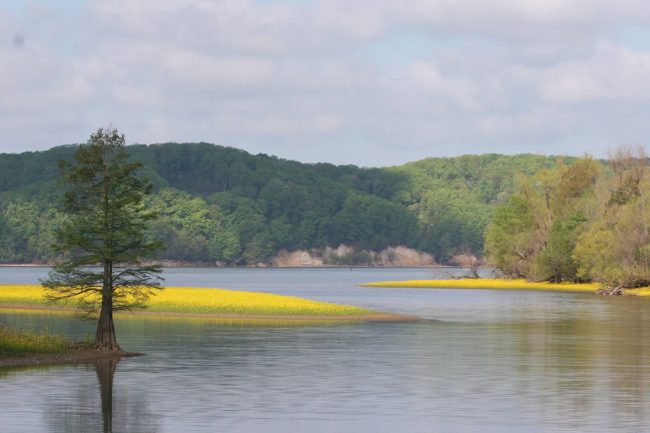
Springville, Tenn.–The seasonally closed roads and bays at the Tennessee and Cross Creeks National Wildlife Refuge (NWR) will re-open as of Wednesday, March 16th. These areas have been closed during winter to lessen disturbance to wintering waterfowl on both these refuges.
Both refuges are managed by the U.S. Fish and Wildlife Service. Cross Creeks NWR is roughly 9,000 acres stretching along 11 miles of the Cumberland River in Stewart county. Tennessee NWR is 51,000 acres along 65 miles of the Tennessee River and encompasses Henry, Benton, Humphreys and Decatur counties.
For those that enjoy birding and observing wildlife, there are many opportunities available at both refuges. At Cross Creeks NWR, wildlife can be viewed at the refuge office, just out the back door on their observation deck, or along a long wildlife drive that parallels the Cumberland River. To find this area with your GPS use the address 643 Wildlife Road in Dover.
On Tennessee NWR, the refuge Headquarters/Visitor Center is located at 1371 Wildlife Refuge in Springville, TN. The Visitor Center is open Monday through Friday from 8:00 to 4:00 pm. Admission is free and groups can request special programs. The facility is also great place for ranger led field trips for students of all ages. The refuge offers bus transportation grants to defray the cost of field trips to the refuge.
Off the back patio of the Visitor Center is a great place to view wildlife. Just adjacent to the visitor center is a pollinator demonstration garden. The V.L. Childs Observation Deck is located just one mile from the visitor center and is a favorite place to view wildlife anytime of the year.
For those that like hiking, there are two trails close to the visitor center. The half-mile, Nature Discovery Trail is an easy trail which gives access to a Kentucky Lake shoreline. It is home to several children’s activity stations called “Animal Olympics” where kids can learn about wildlife while getting a bit of extra exercise. Also located near the visitor center is the 2.5 mile moderate Britton Ford hiking trail which leads visitors through a forested area of the refuge.
Springtime, when the crappie start biting is a great time to go fishing on the refuge. Fishermen are encouraged to obtain a fishing regulations brochure available online at www.fws.gov/refuge/Tennessee or www.fws.gov/refuge/Cross_Creeks. Brochures are also available at information kiosks located at both refuge offices; at the V.L. Childs Observation Deck; at the main entrance to the Duck River Bottoms area; and at the main entrance to the Busseltown Unit; or in area bait and tackle stores.
This brochure has information not only about the use of the refuge for fishing, but maps of both refuges that point out the locations of boat ramps and water control structures. It is also a great resource for those that like to canoe or kayak on the refuge. Both refuges offer peaceful opportunities for paddling or kayak fishing.
At Tennessee NWR just south of New Johnsonville, the Blue Goose Boulevard Wildlife Drive just off Refuge Lane in the Duck River Bottoms will be a phenomenal show just after opening. This 2 mile wildlife observation drive features a green tree reservoir, flooded fields and mud flats that attract a wide number of birds. Near the wildlife drive, an observation deck called Pintail Point Observation Deck is accessible just off of Haul Road providing a photography blind opportunity. To find this area with your GPS, use the address 550 Refuge Lane in New Johnsonville.
On the Big Sandy Peninsula, just north of the town of Big Sandy, the Bennett’s Creek Observation Deck is fully accessible. This 120 foot boardwalk leading to a raised observation deck overlooks a bay of Kentucky Lake and two refuge impoundments. Sitting on this deck listening to the ducks chatter offers a peaceful moment that’s hard to beat. Near the deck is the 1.1 mile Chickasaw National Recreation Trail, a great trail to view a diversity of habitats, see the ruins of an old grist mill and walk through the remains of a homestead site of long ago.
Even though a good number of the waterfowl have left us, there are still plenty coming through to experience. And as they return north, soon the summer migratory birds will come. These birds include the shorebirds and neo-tropical migratory songbirds such as the indigo bunting, prothonotary warbler, white-eyed vireos, orchard orioles, yellow-billed cuckoos and wood thrushes. Oh what a wonderful time to come visit the refuge!
The refuge manager invites the public to take pleasure in the refuge, but remember to obey all regulations and help make it a safe and litter-free place for all to enjoy. For more information about where to visit, call 731-642-2091.



